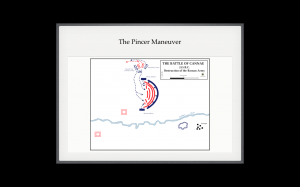First off, I’ve taken a long time to post this because, as I’ve said in my previous post, I’ve never used any kind of PowerPoint/presentation software in my life. I’ve always had Keynote on my Mac, but this is the first time I’ve even opened the application. To that end, it took me forever to find out how to get the slides on here. In fact, I still don’t know how to, and have resorted to taking screenshots of them and pasting them up here. I have no idea how (or if) you can post the actual slides or the presentation on a blog, as I’ve tried to do so about 100 times. Anyway, here is my presentation.
My slideshow is on the Battle Of Cannae. I really feel that one of the things that make PowerPoint so maligned is that it’s boring, repetitive, and most people just read found them like a textbook when presenting. That’s why for my slideshow, I made there as little text as possible. If I was doing a presentation with this slideshow, I’d speak from notes or what I’d have memorized about the battle, instead of putting everything on the slides. For my first slide, I have the title of my presentation, with some subtext, and a picture of Hannibal. Very basic and easy to understand; I’m only trying to get the subject out there. I don’t want to bog my audience down with words and having to read paragraphs. Short and simple.
For my second slide, I have a simple picture of the Roman’s and Carthaginian’s battle movements and formations. In particular, it shows the beginnings of the Roman’s defeat, as Hannibal starts his frontline retreat. This caused the Romans to push forward up the center, leaving there flanks open from Hannibal’s African troops to close them in. It also shows the defeat of the Roman cavalry, which ends up adding more insult to injury in the next stage of the battle.
In the final slide, the Roman’s defeat is show in full effect, with Hannibal’s maneuver completed. What is now known as the pincer maneuver, this is earliest instance of it ever being used, and had devastating consequences for the Romans. As the Roman center pushed forward faster than its flanks, the Carthaginians surrounded them in a crescent, while Hannibal stopped his center’s retreat, effectively capturing the Romans in a deadly semicircle. In most ancient battles, the cavalry would simple sweep through the enemy once, and then go and raid there camp, which was usually empty during the battle. The Carthaginian cavalry though, instead of ransacking the Roman camp, came back around, charging the Romans from behind, and attacking there weak point for massive damage. The Roman’s, helpless and trapped inside a wall of Carthaginians, suffering major loses, with over half their force being killed, and that’s when looking at the smallest recorded casualty listings.
I don’t know if this kinda of meta-analysis of my slideshow is what I should be doing, but I think it works. Looking at my slides, I used them more for things I couldn’t do, such as draw a map of the battle (I mean, I could, but it would be very time-consuming), instead of boring people to death with words and bullet points.



